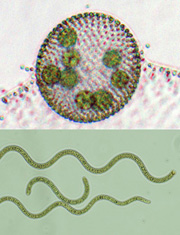Research Interests

We are investigating the mechanism of growth, development and evolution of photosynthetic microorganisms. We are currently focusing on the study of the edible multicellular cyanobacterium Arthrospira (Spirulina) platensis.
Arthrospira platensis is a filamentous alkalophilic cyanobacterium that has been traditionally consumed as food by people living along the shores of alkaline lakes in several regions in the world. It is one of the most protein-rich food known, as it contains as high as approximately 60% protein in dry weight. Because Arthrospira can be cultured under alkaline conditions where growth of other microalgae is suppressed, it can be cultured outdoors as an almost single algal strain. Because of the easiness of its unialgal cultre, Arthrospira is commercially cultured in many subtropical areas in the world and consumed worldwide as food, food additives, and feed for animals and fishes. It is usually marketed with the name spirulina, which is based on its former scientific name, Spirulina. We are currently focusing on developing tools and technologies for molecular genetic study of this cyanobacterium.
The footage below is from a time-lapse movie of the gliding movement of spirulina (A. platensis NIES-39).
Why does spirulina have a spiral shape?
Spirulina (Arthrospira species) is characterized by its helicoid shape. When spirulina is placed on a solid medium, it moves around smoothly on the surface of the medium. Such movement is called "gliding movement" in microbiological terminology. Our recent research has revealed that, during gliding movement, spirulina frequently changes the direction of its movement by taking advantage of its helicoid shape. Also, the helicoid structure contributes to keeping its movement speed almost constant even when the temperature changes so that it does not fall into a runaway state. When the morphology of spirulina becomes linear due to mutations, it loses control of its movement and enters a runaway state. Spirulina's helicoid morphology is thought to have evolved this way so that it can control its movement. [Shiraishi et al., 2024]
Selected Publications
- Shiraishi, H., Sasase, M. and Nakashima, A. S. (2024). Helicoid morphology of Arthrospira platensis NIES-39 confers temperature compensation in the longitudinal movement velocity of its trichomes. Phycology, 4, 104–116. (Full copy)
- Shiraishi, H. and Nishida H. (2023). Complete genome sequence of the edible filamentous cyanobacterium Arthrospira platensis NIES-39 based on long-read sequencing. Microbiol. Resour. Announc. 12, e0113922 (Full copy).
- Shiraishi, H. and Toyoda, A. (2021). The use of a 3-(4,5-dimethylthiazol-2-yl)-2,5-diphenyl tetrazolium bromide-based colorimetric assay in the viability analysis of the filamentous cyanobacterium Arthrospira platensis. Biosci. Biotechnol. Biochem, 85, 739-742. [PMID: 33624771]
- Tadama, S. and Shiraishi, H. (2017). Growth of the edible microalga Arthrospira platensis in relation to boron supply. Int. J. GEOMATE, 12 (No. 30; Special Issue on Science, Engineering & Environment), 90-95. (Full copy)
- Shiraishi, H. (2016). Cryopreservation of the edible alkalophilic cyanobacterium Arthrospira platensis. Biosci. Biotechnol. Biochem. 80, 2051-2057.(PMID: 27240586) (Postprint PDF)
- Shiraishi, H. (2015). Association of heterotrophic bacteria with aggregated Arthrospira platensis exopolysaccharides: implications in the induction of axenic cultures. Biosci. Biotechnol. Biochem. 79, 331-341 (PMID: 25333502) (Postprint PDF, supplemental figures, supplemental video).
- Shiraishi, H. and Tabuse Y. (2013). The AplI restriction-modification system in an edible cyanobacterium, Arthrospira (Spirulina) platensis NIES-39, recognizes the nucleotide sequence 5’-CTGCAG-3’. Biosci. Biotechnol. Biochem., 77, 782-788 (PMID: 23563565) (Postprint PDF).
- Shiraishi, H. (2008). Hatching enzyme of Volvox: a possible implication in the evolution of multicellularity. J. Biochem. Tech. 1, 21-22 (Free full text).
- Fukada, K., Inoue, T. and Shiraishi, H. (2006). A post-translationally regulated protease, VheA, is involved in the liberation of juveniles from parental spheroids in Volvox carteri. Plant Cell, 18, 2554-2566 (PMID: 17028206)
- Aono, N., Inoue, T. and Shiraishi, H. (2005). Genes specifically expressed in sexually differentiated female spheroids of Volvox carteri. J. Biochem., 138, 375-382 (PMID: 16272131).
- Shiraishi, H. (2004). Two-dimensional fractionation of complex mixuture of oligonucleotides in microRNA size range. Nucleic Acids Symp. Series, 48, 293-294 (PMID: 17150594).
- Aono, N., Shimizu, T., Inoue, T. and Shiraishi, H. (2002). Palindromic repetitive elements in the mitochondrial genome of Volvox. FEBS Letters, 521, 95-99 (PMID: 12067734).
- Shimizu, T., Inoue, T. and Shiraishi, H. (2002). Cloning and characterization of novel extensin-like cDNAs that are expressed during late somatic phase in the green alga Volvox carteri. Gene, 284, 179-187 (PMID: 11891059).
- Shimizu, T., Inoue, T. and Shiraishi, H. (2001). A senescence-associated S-like RNase in the multicellular green alga Volvox carteri. Gene, 274, 227-235 (PMID: 11675015).
- Shiraishi, H., Okada, K. and Shimura, Y. (1993). Nucleotide sequences recognized by the AGAMOUS MADS domain of Arabidopsis thaliana in vitro. Plant J., 4, 385-398 (PMID: 8106084).
For other works, please see List of Publications.
H. Shiraishi started his research in a laboratory linked to the so-called "phage group". He is perhaps the last generation who was able to start his research in the reverberation of the Phage Group.

